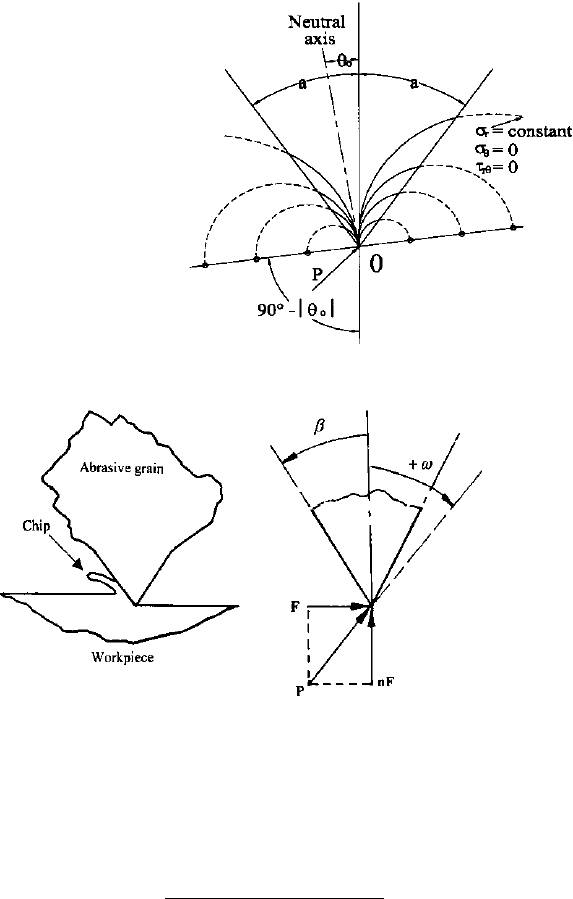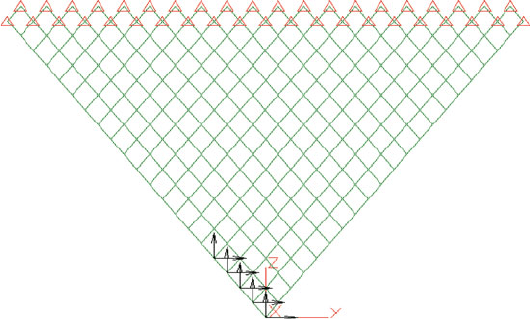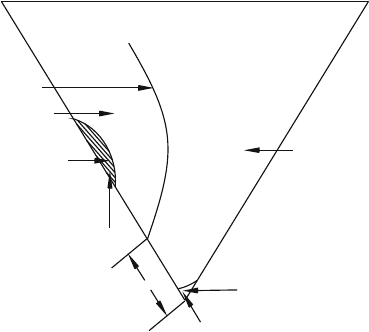Jackson Mark. Machining with Abrasives
Подождите немного. Документ загружается.


P sin o
Z
p
=
2þa
p=2 a
s
r
t r cos y
0
dy
0
¼ 0 (7.14)
P sin o ¼
Z
p
=
2þa
p
=
2a
2C
cos y
0
r
t r cos y
0
dy
0
¼ 2Ct
Z
p
=
2þa
p
=
2a
cos
2
y
0
dy
0
¼C t 2a sin 2aðÞ (7.15)
C ¼
P sin o
tð2a sin 2aÞ
(7.16)
Thus,
s
r
¼
2P cos y
0
sin o
r tð2a sin 2 aÞ
(7.17)
Expressing in terms of the angle y (where y
0
is negative), yields,
s
r
¼
2P cos y sin o
r tð2a sin 2 aÞ
(7.18)
Therefore, the combined stresses are:
s
r
¼
2P
r t
cos o cos y
2a þ sin 2a
þ
sin o cos y
2a sin 2a
(7.19)
It follows that s
r
vanishes for angle y
o
defined using the expression:
tan y
o
¼
1
tan o
2a sin 2a
2a þ sin 2a
(7.20)
This equation corresponds to a straight line through the apex as shown in Fig. 7.10.
This natural axis separates the regions of compressive and tensile stresses. It can be
seen that for values of angle o which gives, |y
o
| > |a|, the neutral axis lies outside the
included angle of the wedge. This means that the whole area of the wedge will be
under stresses of uniform sign. Expressing (7.19) in terms of the rake angle of the
abrasive grain, b, and force components F
t
and nF
t
(Fig. 7.11), yields,
s
r
¼
2F
t
r t
n cosða bÞþsinða bÞ½cos y
2a þsin2a
þ
fcosða bÞn sinða bÞgcosy½
2a sin2a
(7.21)
7 Nanogrinding 315

It can be observed that:
tan o ¼
cosða bÞn sinða bÞ
n cosða bÞþsinða bÞ
(7.22)
In the simple case of a wedge with the normal force nF
t
along the wedge axis, a is
equal to b, hence,
tan o ¼ 1=n (7.23)
Fig. 7.10 Stress analysis of a
single-point loaded wedge.
Used with permission
copyright Springer (2007)
Fig. 7.11 Ideal wedge-shaped cutting point and grinding force diagram. Used with permission
copyright Springer (2007)
316 M.J. Jackson and J. P. Davim

It is interesting to examine the radial stresses on the left-hand face of the wedge,
which corresponds to the leading face of idealized wedge. Thus, for the left-hand
face, y is equal to a, and from (7.19),
s
r
¼
2P
r t
cos o cos a
2a þ sin 2a
þ
cos a sin o
2a sin 2a
(7.24)
This stress is zero, i.e., the neutral axis coincides with the left-hand limit of the
wedge, when,
1
tan o
¼
sin að2a þ sin 2aÞ
cos að2a sin 2aÞ
(7.25)
Thus if,
(a) a ¼b, then,
n ¼
sin a
cos a
2a þ sin 2a
2a sin 2a
(7.26)
(b) a b ¼ p=2 a
(as is the case when F
t
is parallel to the right-hand face of the wedge).
From (7.23),
tan o ¼
sin a n cos a
n sin a þ cos a
¼
sin a n cos a
n sin a þcos a
(7.27)
And substituting in (7.25), yields,
n sin a þcos a
sin a n cos a
¼
sin a
cos a
2a þ sin 2a
2a sin 2a
(7.28)
1
2
n sin 2a þ cos
2
a
sin
2
a
1
2
n sin 2a
¼
2a þ sin 2a
2a sin 2a
(7.29)
1
2
n sin 2að2a sin 2aÞþ2acos
2
a cos
2
a sin 2a
¼ 2a sin
2
a þ sin
2
a sin 2a
1
2
n sin 2að2a þ sin 2aÞ
1
2
n sin 2að2a sin 2a þ 2a sin 2aÞ¼2aðsin
2
a cos
2
aÞþsin 2a
n ¼
1
2a
cot 2a (7.30)
7 Nanogrinding 317
Equation (7.25) expresses the condition for the whole of the wedge’s cross-sec-
tional area to be under compressive stress. It can be seen that this depends not only
upon the rake angle, b, but also upon the ratio, n. In general the relative size of the
region of compressive to the region of tensile stresses depends upon b and n as
(7.20) and (7.22) indicate. Also, from (7.21), the magnitude of the stress on the left-
hand face of the wedge is found to be dependent upon the tangential force
component, F
t
, and the force component ratio, n. Referring to (7.19), it can be
seen that for constant stress, s
r
¼constant,
r C
1
¼ C
2
cos y þ C
3
sin y (7.31)
where C
1,
C
2
,C
3
are constants. Equation (7.31) represents, in polar co-ordinates,
the circumference of a circle tangent to the line,
0 ¼ C
2
cos y þ C
3
sin y (7.32)
that is to the neutral axis at the point r ¼0. However, the point r ¼0 must be
considered separately because the stress at that point approaches infinity, since by
definition P is a point load. The central point of these circles are of constant radial
stress, and so the point of constant maximum shear stress must lie on a line
perpendicular to the neutral axis at the point where r is equal to zero. The radius
of each of those circles depends upon the magnitude of the radial stress, s
r
.
7.5.2 Fracture Dominated Wear Model
Brittle materials exhibit high strength properties when loaded in compression than
in tension. The ratio of rupture strengths is usually between 3:1 and 10:1. The
existence of relatively low tensile stresses in the abrasive grains may cause failure
by fracture to occur. To model the action of diamonds bonded to piezoelectric
ceramics, one must consider a single active cutting grain to be classed as a wedge of
constant width loaded at its inverted apex with point loads, F, and, nF, which
represent the radial and tangential force components with reference to the grinding
wheel in which the grain is supported, and P is the resultant force.
The stress distributions within point-loaded wedges can be determined analyti-
cally, and the results of such an analysis indicate that if tensile stresses exist within
the wedge then it will occur at its maximum along the rake face. The existence of a
tensile stress depends on the magnitude of the force ratio, n. If the ratio is especially
small that a tensile stress exists in the wedge, then for a specific force ratio the
tensile stress is proportional to the tangential grinding force, F. Stresses of this
nature would extend to and beyond the abrasive grain-bonding interface. The
fracture of abrasive grain, bonding phase, or the interface between the two, depends
on the particular type of piezoelectric ceramic material used and the magnitude of
the tensile stress induced during nanogrinding. Grains of diamond are ten times
318 M.J. Jackson and J. P. Davim
stronger in compression than in tension. The probability of grain fracture is likely to
increase with an increase in tensile stress exerted in the grain although the magni-
tude of the stress may be slightly higher than one-fifth the magnitude of the
maximum compres sive stress in the grain. A significant barrier to the acceptance
of stress patterns evaluated for such situations arises because point loads applied to
perfectly sharp wedges produce infinitely high stresses at, and about, the point of
contact. Loads must be applied over a finite area. It seems likely that higher tensile
stresses are associated with higher grain fracture probability resulting in rapid loss
of diamond grains and, consequently, lower grinding ratios. The wear model should
incorporate the fact that the loads are spread over a finite area. This implies that
point loads are applied along the rake face. The model should allow the examina-
tion between the wear rate of a diamond coat ed piezoelectric ceramic material and
the general nature of stresses established in active cutting grains subjected to
nanogrinding forces. This means that it is necessary to estimate the force compo-
nents of grinding on each active cutting grain.
7.5.3 Nanogrinding Procedure
The experimental apparatus consisted of holding a polished specimen between the
jaws of a vice so that a piezoelectric crystal oscillator traverses back-and-forth the
specimen thus machining the specimen by creating a depth of cut between the
diamonds adhered on the piezoelectric crystal and the workpiece material. Work-
piece materials were polished with a 100 nm sized polishing compound. All samples
were divided into four sections and each section was analyzed prior to machining
and after machining occurred. The workpieces were mounted in a vice that was
attached to a x-y-z linear slide in order to achieve accurate positioning of the
workpiece. The piezoelectric crystal was mounted on a steel framework that was
orthogonal to the workpiece. The whole unit was located within a tetrahedral space
frame to dampen excess vibrations (Fig. 7.12). When the crystal and workpiece
were aligned, the depth of cut was incremented in stages of 10 nm. The motion of
the diamonds attached to the piezoelectric crystal generates a machining effect that
is cause d by the action of diamonds grinding into the workpiece material. Tracks or
trenches are created by the diamond grain gouging the surface of the material when
an electric current is applied. The material is removed until the end of the oscillat-
ing motion creates the mater ial to plow.
The mechanism of oscillation can be described as a restricted bending mode that
simulates a shear displacement of the crystal. At this point it is normal procedure to
know how to estimate the number of grains contacting the surface of the workpiece.
The estimation of the number of active cutting grains is estimated quite simply by
driving the diamond coated piezoelectric ceramic at the prescribed specific metal
removal rate into a piece of lead. The impression that the grinding wheel produces
in the length of lead is equal to the number of cutting points that are active during
the grinding stroke at that particular depth of cut. The effect of oscillating the
diamond-coated crystal is shown in Fig. 7.13.
7 Nanogrinding 319

The motion of the diamonds imparted by oscillating the crystal in the bending
mode that causes a shear displacement to occur, which contributes to plowing of the
material at the end of the nanogrinding stroke, is shown in Fig. 7.14 .
Fig. 7.12 Machining center capable of nanogrinding
Fig. 7.13 Material removal by oscillating a diamond-coated piezoelectric ceramic crystal. Used
with permission copyright Springer (2007)
320 M.J. Jackson and J. P. Davim

Fig. 7.14 Plowed material at the end of a nanomachined track. Used with permission copyright
Springer (2007)
Fig. 7.15 Nanomachined tracks in steel. Used with permission copyright Springer (2007)
7 Nanogrinding 321

The effect of using the piezoelectric to machine tracks, or trenches, in engineering
materials opens up the prospect of nanomanufacturing products that require geomet-
ric features such as channels so that fluids and mixed phase flows can be manipulated
in devices such as micro-and nanofluidic “lab-on-a-chip” products. Figure 7.15
clearly shows such a channel produced using the piezoelectric nanogrinding process.
The mea sured force components of the nanogrinding operation are measured
using a dynamometer. These components of force are then applied to a model
abrasive grain by dividing the grinding force data into the number of active cutting
grains over an area that simulates the abrasive grain-workpiece contact area.
Stresses established in this area are calculated using finite elements. The wear of
the piezoel ectric material by diamond loss, expressed in terms of a grinding ratio,
and its relationship to the stress levels set up in the model grain is investigated using
a stress analysis method.
7.5.4 Stress Analysis
The assumed geometry of an ideal grain in the vicinity of its cutting edge is a simple
symmetrical wedge of constant width with an included angle of 70
that results in a
rake angle of 35
. There is no wear flat on the model cutting grain. In order that a
finite element method is used to evaluate stresses in the wedge, the wedge was
subdivided into 210 diamond-shaped elements with a total of 251 nodes. Forty-one
nodes were constrained at the boundary of the wedge and the leading five nodes on
the rake face were loaded (Fig. 7.16). The tangential and normal grinding forces
were replaced by equivalent forces acting perpendicular to (normal load) and along
(shear load) the rake face of the wedge.
Fig. 7.16 Finite element assemblage with grinding loads applied at the rake face nodes. Used with
permission copyright Springer (2007)
322 M.J. Jackson and J. P. Davim

The concentrated loads at the five nodes are representative of the distributed and
normal loads acting on the rake face over the abrasive grain-chip contact length.
The normal force distribution on the rake face was taken to be maximum at the
cutting edge and decreasing linearly to zero at the end of the abrasive grain-chip
contact length. The shear force was taken to be constant over the first half of the
contact length, decreasing linearly to zero over contact length.
Grinding loads were also applied directly to the rake face and at the tip of the
grain without calculating equivalent forces. This was performed in order to com-
pare and contrast the effect of different force distributions on the stresses generated
within the wedge.
To measure the value of using the maximum tensile stress as a way to estimate
grain fracture tendency, the correlation between the two sets of data were calculated
for each set of data. The region of fracture initiation was also located using
Griffith’s criterion of fracture. For,
s
c
s
t
s
1
þ s
3
>0 (7.33)
Then,
s
1
¼ s
t
(7.34)
But for,
s
c
s
t
s
1
þ s
3
<0 (7.35)
Then,
s
1
jj
s
3
jj
ðÞ
2
þ 8s
t
s
1
jj
s
3
jj
ðÞ¼0 (7.36)
where s
1
and s
3
are the principal stresses, assuming that s
1
>s
3
, s
t
is the ultimate
tensile strength of the abrasive grain, and s
c
is the ultimate compressive strength.
For diamond grain material, the ratio of s
t
and s
c
is 0.1.
The results of the two-dimensional stress analyses were consistent with the
experimentally determined stress distribution obtained by Loladze [6] when cutting
soft metal with photoelastic tools. The maximum tensile stress always occurs at the
rake face at a distance from the cutting edge ranging from 1.5 to four times the
abrasive grain-chip contact length, the exact magnitude of the coefficient depends
on the loading conditions for a particular machining event. For a given value of the
tangential force com ponent, F, the higher the force ratio, F/nF, the greater the
distance the maximum tensile stress is away from the cutting edge.
These results indicate that mechanically induced fracture occurs at a finite
distance away from the cutting edge. When using Griffith’s criterion, the influence
7 Nanogrinding 323

of mechanically induced stresses indicate that fracture initiation zones are estab-
lished. Figure 7.17 shows the occurrence of such zones in an idealized wedge.
The first zone is located around the point of maximum tensile stress and is always at
the rake face.
Failure in this zone is tensile in nature and would initiate fracture at a point on the
rake face of the order of two-to-three times the abrasive grain-chip contact length
away from the cutting edge. This type of fracture is consistent with fracture on scale
comparable with the chip thickness. The second much smaller zone is located at the
immediate vicinity of the cutting edge. Failure is compressive in this region and
results in small-scale crumbling of the cutting edge leading to the formati on of a
wear flat on the abrasive grain. The correlation between the magnitude of the
maximum tensile stress in the model abrasive grains and the appropriate grinding
ratio (Table 7.1) is high and is dependent on the way the forces are applied to the
grains. It would be expected that the higher the tensile stress, the greater is the rate of
diamond wear and consequently the corresponding grinding ratio. Perfect linear
correlation in accordance with this woul d result in a correl ation coefficient of 1.
The correlation coefficient between the maximum tensile stress and the grinding
ratio is significant. This is to be expected as the force ratio may vary slightly.
However, if the tangential component of the grinding force changes significantly
without a change in force ratio, then it is expected that the maximum tensile stress
will change significantly and reduce the grinding ratio. The calculation and appli-
cation of equivalent grinding loads produce a lower correlation coefficient com-
pared to directly applied grinding loads. This implies that grinding loads are simply
not point loads acting act the tip of the inverted apex and along the abrasive grain-
chip contact length of the diamond grain. In fact, directly applied grinding forces
σ
+M
Zone of dangerous
points (σ
1
≥σ
b
: tensile
fracture)
Sample size of zone of
dangerous points for
compressive failure,
σ
3
≥
σ
−b
σ
1
+ 0.2σ
3
= 0
σ
1
+ 0.2σ
3
> 0
σ
1
+ 0.2σ
3
< 0
Contact length
σ
−M
Fig. 7.17 Griffith’s criterion applied to the idealized wedge showing tensile and compressive
fracture initiation zones. Used with permission copyright Springer (2007)
324 M.J. Jackson and J. P. Davim
